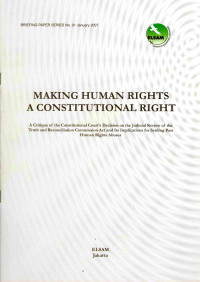
Text
Making Human Rights A Constitutional Right Menjadikan Hak Manusia sebagai Hak Konstitusional
On December 7, 2006, the Constitutional Court finally gave its decision on two petitions for a judicial review of Act No. 27/2004 on the Truth and Reconciliation Commission (from hereon referred to as TRC Act), but it came up with different decisions. The first decision was on case No. 006/PUU-IV/2006, stating that the Constitutional Court accepted the petition of the petitioners. It declared that the TRC Act conflicted with the 1945 Constitution and that the TRC Act did not have any binding force. On the other hand, the Constitutional Court’s second decision, No. 020/PUU-IV/2006, stated that the petitioner’s petition was not accepted, because of the fact that the law on which the petitioner’s request was based, was not binding legally.1 The decision of the Constitutional Court to scrap the TRC Act surprised many parties. It is perceived as ironic, considering the efforts that the victims have put into demanding accountability for past abuses through the only recognized legal framework available to them, namely, the TRC Act. This Act is a legal pillar upholding the demand for political commitment on the part of the government not to avoid its responsibility for past abuses, as well as to ensure that the same tragedy does not recur in the future. Nevertheless, the contents of the said Act did not fully satisfy the sense of justice of the victims. Because of this, together with other actors and concerned activists, they asked for a judicial review. Their attempt to improve the Act focused particularly on three important points: the articles on amnesty, on giving compensation that depends on amnesty, and on the character of the TRC as a substitutive mechanism for a court.
Availability
| KP.1.000300 | KP.1 SAP m | My Library | Available |
Detail Information
- Series Title
-
-
- Call Number
-
KP.1 SAP m
- Publisher
- Jakarta Indonesia : Elsam., 2007
- Collation
-
25 hlm; 30 cm
- Language
-
English
- ISBN/ISSN
-
-
- Classification
-
KP.1
- Content Type
-
-
- Media Type
-
-
- Carrier Type
-
-
- Edition
-
First, 1 January 2007
- Subject(s)
- Specific Detail Info
-
Briefing Paper Series No. 01 January 2007 : A Critique of the Constitutional Court's Decision on the Judicial Review of the Truth and Reconciliation Commission Act and Its Implications for setting past Human Rights Abuses
- Statement of Responsibility
-
-
Other version/related
No other version available
File Attachment
Comments
You must be logged in to post a comment
 Computer Science, Information & General Works
Computer Science, Information & General Works  Philosophy & Psychology
Philosophy & Psychology  Religion
Religion  Social Sciences
Social Sciences  Language
Language  Pure Science
Pure Science  Applied Sciences
Applied Sciences  Art & Recreation
Art & Recreation  Literature
Literature  History & Geography
History & Geography